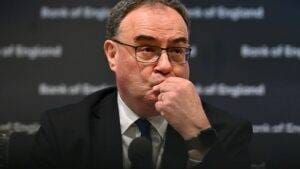The Bank of England has cut interest rates to 4%, their lowest level in more than two years, following a split vote among policymakers that reflects deep uncertainty over the UK’s economic outlook.
In a historic two-round vote, the Bank’s Monetary Policy Committee (MPC) voted 5-4 in favour of a 0.25 percentage point reduction, lowering the base rate from 4.25%. It marks the fifth quarter-point cut in the past 12 months and the first time since the MPC’s formation in 1998 that two ballots were needed to reach a decision.
The initial vote was evenly divided, with four members favouring a cut, four preferring to hold, and one voting for a larger 0.5-point cut. In the second round, five members backed the quarter-point reduction that ultimately prevailed.
The cut, announced at midday on Thursday, comes despite a rise in inflation to 3.6% in June, and represents a carefully balanced move to support a weakening economy under pressure from tax hikes, falling consumer demand, and rising unemployment.
“This was a finely balanced decision,” said Governor Andrew Bailey. “Future rate cuts will need to be made gradually and carefully.”
The Bank’s decision comes as GDP contracted in April and May, unemployment hit a four-year high of 4.7%, and payrolled staff numbers fell for five consecutive months, partly due to April’s £25 billion increase in employers’ National Insurance contributions.
While inflation is expected to climb further to 4% in September, the MPC majority judged that the economic headwinds now justify more accommodative policy.
“There has been sufficient progress on inflation, but we’re also seeing higher layoffs and sluggish consumer spending,” the Bank said.
Alan Taylor, an external MPC member who initially supported a larger rate cut, changed his vote in the second round, warning of an “increased recession risk” if monetary policy remained too tight.
However, Huw Pill, the Bank’s chief economist, and three other members voted to hold rates, citing concern over wage-price spirals and arguing that more data was needed to confirm a sustained downward trend in inflation.
The Bank now expects inflation to remain above its 2% target until well into 2026, driven by:
Higher food and energy prices
A 6.7% rise in the minimum wage
Secondary inflation from April’s NICs hike
It also warned that September’s inflation rate, which determines uprating of benefits and the state pension, would likely be higher — fuelling speculation about increased fiscal pressure heading into the autumn.
The Bank added that the inflationary backdrop may be further complicated by President Trump’s incoming tariffs, which could shave 0.2% off UK GDP over three years. However, re-routed goods from other countries may exert downward pressure on UK prices.
Despite the rate cut, the Bank only made a modest upgrade to its growth forecast, projecting GDP to rise 1.25% in 2025, 1.25% in 2026, and 1.5% in 2027.
Unemployment is now forecast to peak at 4.9%, up from 4.7% currently — reflecting rising job losses across multiple sectors.
“The economy remains in a fragile state, and the outlook is highly uncertain,” the Bank said. “Monetary policy is not on a pre-set path.”
The rate cut offers some relief for mortgage holders, SMEs, and retail borrowers, especially after two years of rapidly rising borrowing costs. However, persistent inflation and rising wage bills continue to weigh on employer confidence, particularly in labour-intensive sectors.
Markets now expect the Bank to make at least two further cuts by mid-2026, with the base rate potentially reaching 3.5%.
Economists warn that while the easing in rates will help offset some of the drag from fiscal tightening — including National Insurance and corporation tax increases — businesses should prepare for continued volatility, both at home and abroad.
Read more:
Bank of England cuts interest rates to 4% in historic two-round vote amid economic slowdown

